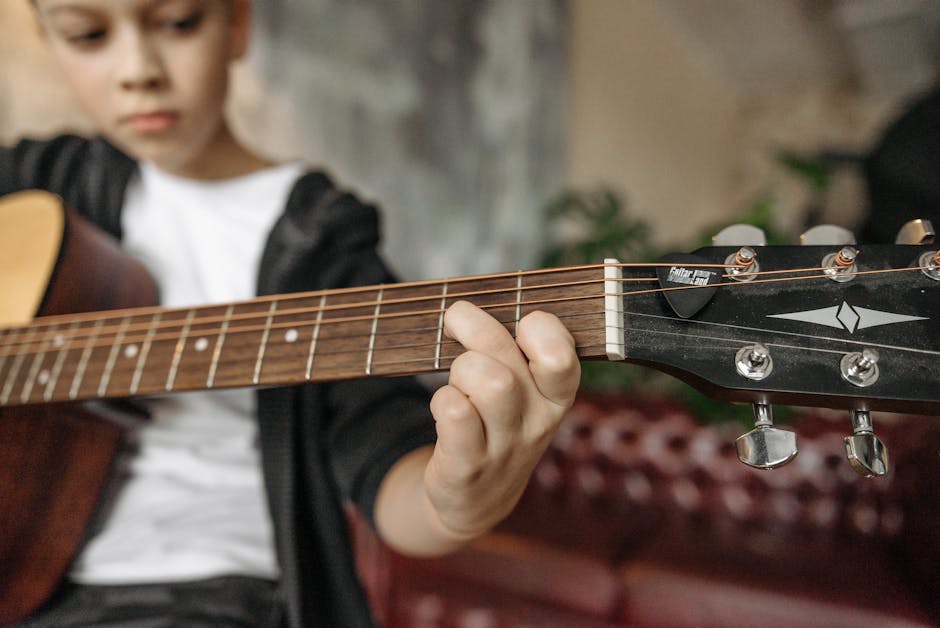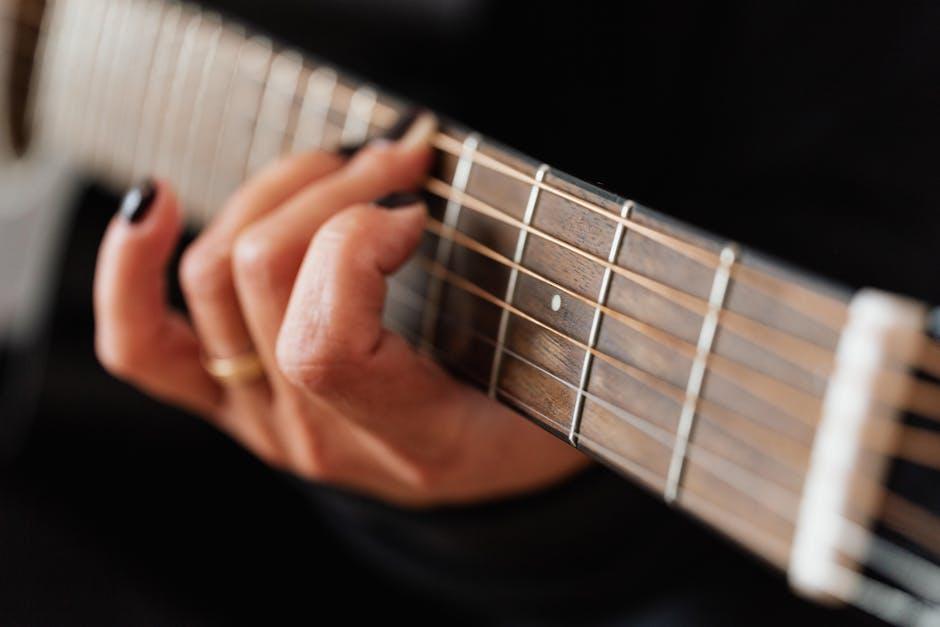Welcome to the wonderful world of fingerstyle guitar! If you’ve ever looked at your fingers and thought, “Hmm, these could be doing more than just texting and eating chips,” then you’re in the right place. In this beginners guide, we’ll be delving into the basics of fingerstyle guitar, teaching you how to make those digits dance across the strings like a pack of caffeinated spiders on a hot tin roof. So grab your guitar, put on your best finger-picking pants, and let’s make some beautiful music together (or at least try not to break any strings in the process).
Contents
- 1
- 2 The Fundamentals of Finger Picking Patterns
- 3 Adopting the Correct Hand Position for Optimal Performance
- 4 Exercises to Develop Finger Independence and Strength
- 5 Mastering Basic Fingerstyle Songs and Progressions
- 6 The Importance of Consistent Practice and Patience
- 7 Exploring Advanced Techniques to Elevate Your Fingerstyle Guitar Play
- 8 FAQs
- 9 Time to Strum Away!
anatomy-of-fingerstyle-guitar”>Understanding the Anatomy of Fingerstyle Guitar
Fingerstyle guitar is like a magical dance between your digits and the strings. It’s a bit like having a tiny orchestra right at your fingertips (literally!). To truly master this art form, you need to understand the anatomy of your guitar-playing hand. Let’s take a closer look at what makes fingerstyle guitar tick!
The Thumb: This mighty digit is responsible for holding down the bass notes and keeping the rhythm in check. It’s like the drummer of the hand, laying down the foundation for the rest of your fingers to dance on.
The Index Finger: This is where the melody magic happens! Your index finger is like the lead singer of the band, hitting those high notes and bringing the melody to life with each pluck of the string.
The Middle, Ring, and Pinky Fingers: These three amigos work together to add depth and complexity to your fingerstyle playing. They create harmonies, embellishments, and textures that make your music sing and dance like never before. Don’t underestimate the power of the pinky – it may be small, but it’s mighty!

The Fundamentals of Finger Picking Patterns
So you wanna learn some fingerpicking patterns, eh? Well, you’ve come to the right place! Let’s dive right in and uncover the secrets to mastering this coveted guitar technique.
First things first, you gotta get those fingers moving. It’s like a dance party on your guitar strings! Start by practicing some basic patterns to get the hang of it. Think of your fingers as little dancers, each with their own special moves.
Next up, experiment with different combinations of fingers. Mix and match like you’re at a puzzle party! Try using your thumb for the bass notes and your other fingers for plucking the higher strings. The possibilities are endless, so don’t be afraid to get creative.
Remember, practice makes perfect. Rome wasn’t built in a day, and neither was a killer fingerpicking technique. Keep at it, stay patient, and before you know it, you’ll be fingerpicking like a pro. So grab your guitar, flex those fingers, and let the fingerpicking frenzy begin!

Adopting the Correct Hand Position for Optimal Performance
So you’re looking to up your game by , huh? Well, you’ve come to the right place! Let’s dive right in and talk about how to position your hands like a pro.
First things first, make sure your hands are relaxed and not clenched into tight fists. You want them to be loose and flexible, like a ninja ready for action. Remember, you’re not trying to crush your controller or mouse - you’re trying to finesse your way to victory.
Next, let’s talk about hand placement. **Keep your wrists straight and avoid any awkward angles that could lead to discomfort or even injury.** Your hands should feel comfortable on the keyboard or controller, like they were meant to be there all along.
- Rest your palms gently on the surface, as if you were caressing a fluffy kitten.
- Make sure your fingers are curved and ready to strike, like the mighty claws of a tiger.
- And don’t forget to maintain good posture – sit up straight and proud, like the gaming champion you are.

Exercises to Develop Finger Independence and Strength
Do you wish you could play the piano with the agility of Mozart or type on a keyboard as effortlessly as a professional typist? Well, you’re in luck! We’ve compiled a list of exercises that will help you develop finger independence and strength.
First up, try the Spider Crawl: Begin by placing your hand flat on a table with your fingers spread apart. Lift each finger one at a time while keeping the rest of your hand and fingers firmly on the table. Pretend you’re a spider slowly making its way across a web. This exercise will help improve the individual dexterity of each finger.
Next, give the Finger Push-Ups a go: Extend your fingers straight out and then bend them at the knuckles as if you’re doing a push-up. Repeat this motion several times, feeling the burn in your fingertips. This exercise will not only build strength but also increase flexibility in your fingers.
For an extra challenge, try the Finger Piano: Imagine you’re playing a tiny piano with your fingertips by tapping each one in succession. Start slowly and then increase your speed as you become more confident. This exercise will help improve your finger coordination and make you feel like a maestro in no time.

Mastering Basic Fingerstyle Songs and Progressions
So you’ve decided to delve into the world of fingerstyle guitar playing, huh? Good for you! It’s a skill that will surely impress your friends at the next campfire jam session. But before you start tackling those complex arrangements, it’s important to master the basics first.
First things first, make sure you’ve got your fingerpicking technique down pat. Remember, the thumb is in charge of the bass notes, while the other fingers handle the melody and harmony. Keep those nails trimmed and don’t be afraid to experiment with different finger combinations!
Next up, start practicing some simple fingerstyle songs and progressions to get a feel for how everything comes together. Start with easy tunes like “House of the Rising Sun” or “Blackbird” by The Beatles. These songs will help you build your finger dexterity and coordination.
Don’t be discouraged if it takes some time to master these songs – Rome wasn’t built in a day, ya know! Just keep at it, and soon enough you’ll be fingerpicking like a pro. And who knows, maybe one day you’ll be the next Tommy Emmanuel or Sungha Jung!
The Importance of Consistent Practice and Patience
Patience and consistency are key ingredients to success in any endeavor, including learning a new skill or hobby. Without these two qualities, you’re bound to get frustrated and give up before you ever see any progress. It’s like trying to bake a cake without following the recipe or waiting for it to bake – you’ll end up with a hot mess of ingredients that never quite come together.
Consistent practice is like watering a plant - if you forget to water it for weeks on end, it’s going to wither and die. But if you water it regularly, it will grow and flourish. The same goes for any skill you’re trying to develop. Whether it’s playing an instrument, learning a new language, or perfecting your cooking skills, you need to put in the time and effort consistently to see improvement.
Patience, on the other hand, is like waiting for a pot of water to boil. If you keep checking on it every two seconds, it’s going to take forever to reach that boiling point. But if you leave it be and trust that it’s heating up, before you know it, you’ll have a bubbling pot of water ready for your pasta. So, trust the process and have faith that your hard work will pay off in the end.
In the end, consistent practice and patience are like the dynamic duo of success. They work hand in hand to help you achieve your goals and dreams. So, the next time you feel like giving up or getting frustrated because you’re not seeing immediate results, remember to stay the course, keep practicing, and trust that success will come in due time.
Exploring Advanced Techniques to Elevate Your Fingerstyle Guitar Play
Looking to take your fingerstyle guitar playing to the next level? Look no further! We have compiled a list of advanced techniques that will have you playing like a seasoned pro in no time. So grab your guitar, warm up those fingers, and let’s dive in!
First up, let’s talk about fingerpicking patterns. Sure, you may be comfortable with the basic alternating bass pattern, but why not spice things up with some more intricate patterns? Try experimenting with Travis picking or clawhammer techniques to add some flair to your playing.
Next, let’s chat about percussive techniques. Adding percussive elements to your playing can really make your guitar work stand out. Consider incorporating techniques such as slaps, taps, and harmonics to create a dynamic and engaging sound.
Lastly, don’t forget about incorporating hybrid picking into your repertoire. This technique involves using both your pick and fingers to pluck the strings, allowing for a wider range of tones and textures. Experiment with different finger combinations and see how this technique can take your playing to new heights.
FAQs
Why is fingerstyle guitar playing superior to using a pick?
Because using a pick is so mainstream. Fingerstyle playing allows you to really connect with the strings and produce a more dynamic and nuanced sound. Plus, who needs a tiny piece of plastic when you’ve got ten perfectly good fingers at your disposal?
Are long nails necessary for fingerstyle guitar playing?
Not unless you’re going for the Freddy Krueger look. While some players prefer long nails for added precision, it’s totally possible to rock out with short nails too. Just make sure to trim and file them regularly to avoid any unwanted snags.
How can I improve my finger dexterity for fingerstyle playing?
Start by practicing your scales and exercises religiously. Think of it as finger calisthenics – but way more fun. And don’t forget to stretch those digits before you dive into a jam session. You wouldn’t want to pull a muscle mid-solo, now would you?
What are some common mistakes beginners make when learning fingerstyle guitar?
Oh, where do I begin? Playing too fast, neglecting proper finger placement, hunching over like Quasimodo – the list goes on. Remember, it’s not a race to see how quickly you can shred. Take your time, master the basics, and the rest will follow. And for the love of all that is melodic, sit up straight!
Do I need a specialized fingerstyle guitar to get started?
Not necessarily. While there are guitars specifically designed for fingerstyle playing, you can make do with whatever you’ve got. As long as your instrument is in good shape and you’ve got the passion to learn, you’ll be fingerpicking like a pro in no time. Who needs fancy gear when you’ve got raw talent, am I right
Time to Strum Away!
Well, folks, that’s all she wrote for our beginner’s guide to mastering fingerstyle guitar basics. We’ve covered everything from proper hand positioning to nailing down those tricky fingerpicking patterns.
So go ahead, grab your guitar, and start strumming away like a pro! Remember, even the greatest guitarists had to start somewhere – and that somewhere is right here, with our helpful guide.
Now go forth and make beautiful music – and don’t forget to have fun in the process! Happy strumming!



